Vintage Treasures: Sandkings by George R.R. Martin
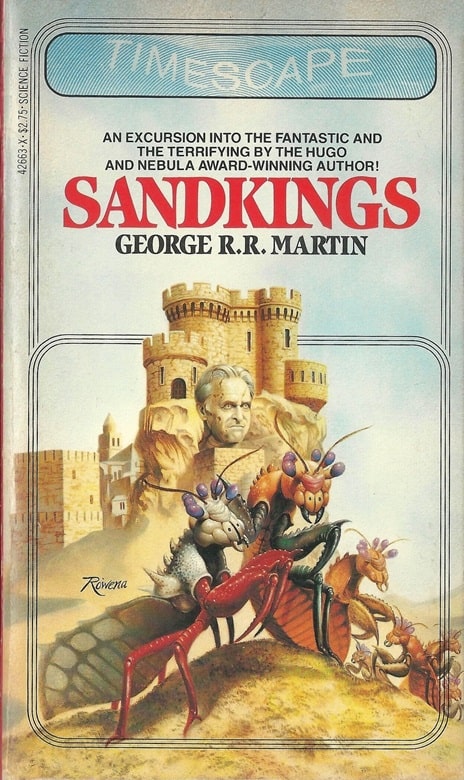 |
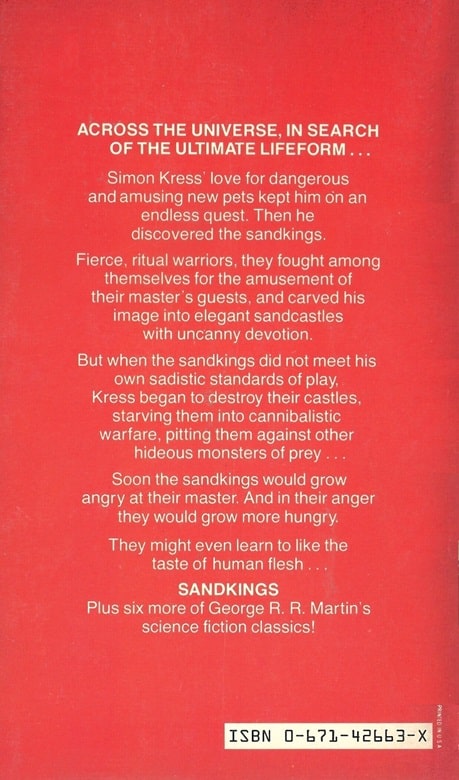 |
Sandkings (Timescape/Pocket Books, December 1981). Cover by Rowena Morrill
Writing is a notoriously poor-paying profession. In 2017, after eleven months of work, I sold my first novel to Houghton Mifflin for $20,000 — about $10,000 below the poverty line for a family of five in Illinois. And I felt lucky to get it, believe me.
So when someone like George R.R. Martin earns $9 million a year as a fantasy novelist, it generates a lot of wonder and amazement. And in some corners, envy and resentment. For George — who’s dedicated his career to SF and fantasy, and was famous for hosting hundreds of fans every year at the genre’s social highlight, the Hugo Loser’s Party at Worldcon — I think the resentment culminated in 2021, when Natalie Luhrs’s essay “George R.R. Martin Can Fuck Off Into the Sun” was nominated for a Hugo Award. George, who was the Toastmaster for the Hugos in 2020, has not attended a Worldcon since.
In light of the fact that The Winds of Winter, sixth novel in the series, in now roughly a decade late, there’s also been a grumbling reevaluation of Martin’s magnum opus, Game of Thrones, with fans bitterly divided over everything from the final season of the HBO series to whether the series is worth starting at all.
To me, this whole exercise is misguided. Regardless of how you feel about the vast media franchise Game of Thrones, George R.R. Martin’s reputation as one of the most vibrant and groundbreaking authors of genre fiction was irrevocably established four decades ago with a string of brilliant short stories, including the Hugo-Award winners “A Song for Lya,” “The Way of Cross and Dragon,” and, especially “Sandkings,” one of the finest SF stories ever written.
[Click the images for sandking-sized versions.]
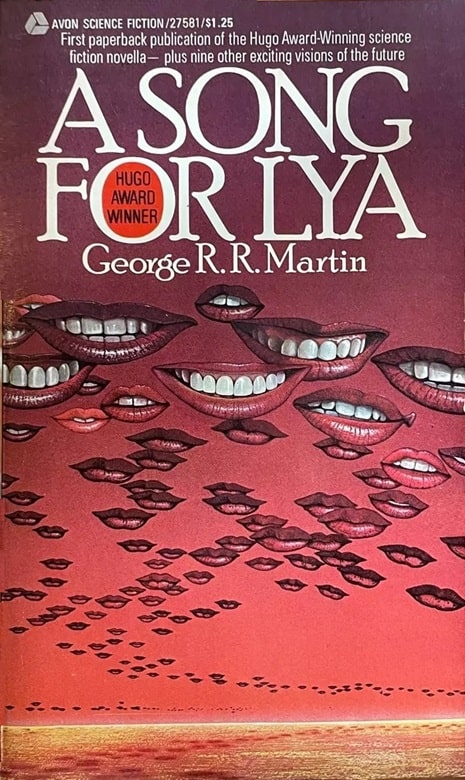 |
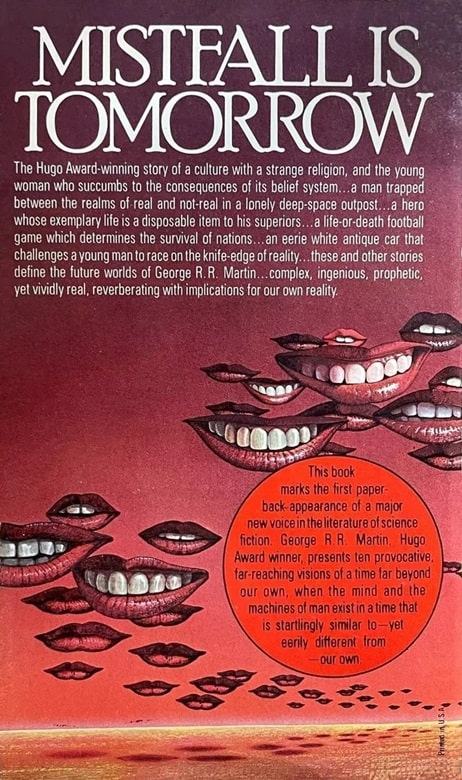 |
George’s first collection A Song for Lya and Other Stories
(Avon, February 1976). Cover by Patrick Woodroffe
“Sandkings” was published in the August 1979 issue of Omni magazine (which I read in an airport in Ottawa, Canada), and included in Martin’s collection Sandkings in December 1981. Sandkings was his third collection, following A Song for Lya and Other Stories (1976) and Songs of Stars and Shadows (1977), and preceding Nightflyers (1985), Tuf Voyaging (1986), and Portraits of His Children (1987).
The collection won the Locus Award for Best Collection in 1982.
All but one of the stories in Sandkings take place in Martin’s far-future Thousand Worlds milieu, setting for his novel Dying of the Light and many of his most famous tales, including “Sandkings,” “Nightflyers,” “A Song for Lya,” “The Way of Cross and Dragon,” and his popular Tuf Voyaging cycle.
In his massive 2003 collection GRRM: A RRetrospective, George shared the origin of the story, and his plans for a longer series of tales featuring the mysterious proprietors, one of whom was likely a Sandking himself. As reported in Wikipedia:
Martin was inspired by a college friend at Northwestern University who had a piranha tank and would sometimes throw goldfish into it between horror film screenings. He had planned for it to be part of a trilogy, with Wo and Shade running businesses on several worlds, but the concept fell through.
“Sandkings” has enjoyed multiple adaptations, including a DC Science Fiction Graphic Novel version from Doug Moench, Pat Broderick and Neal McPheeters (1987), and an episode of The Outer Limits relaunch written by Melinda M. Snodgrass. Netflix announced a feature based on the story in 2021 with Gore Verbinski attached to direct, but nothing has come of it so far.
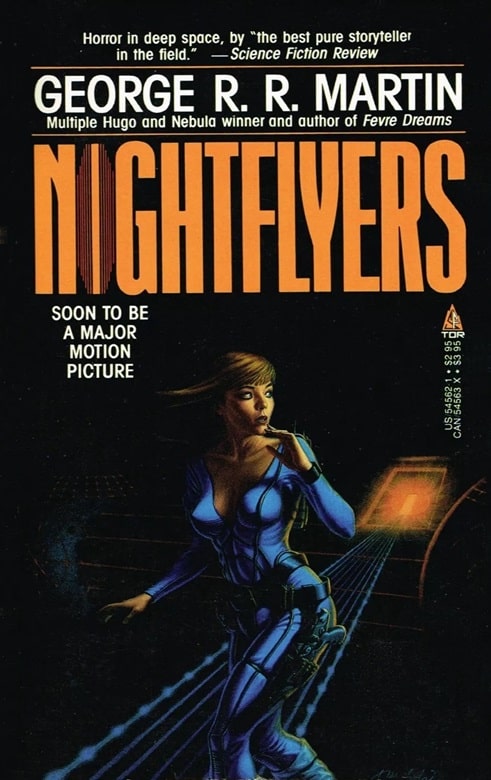 |
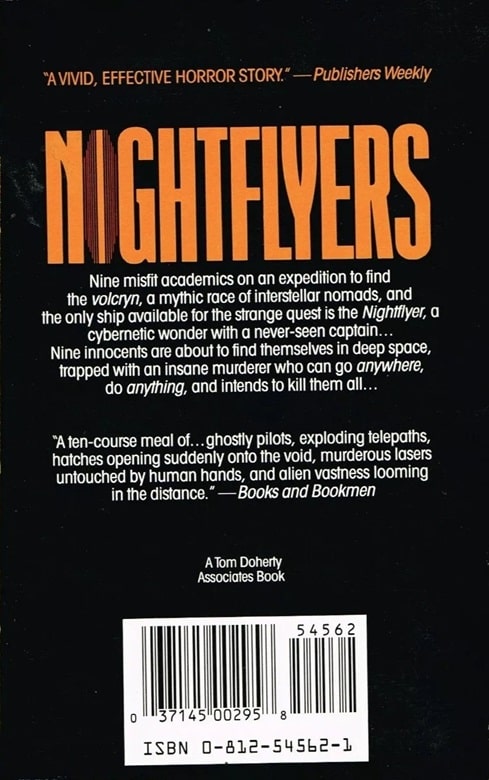 |
George’s third collection Nightflyers (Tor paperback reprint, February 1987). Cover by James Warhola
Steven H Silver reviewed “Sandkings” for us as part of his Golden Age of Science Fiction series back in 2019.
Simon Kress is depicted from the start as arrogant and cruel… his decadent lifestyle centers on the collection, exhibition, and eventual discarding of various exotic animals/aliens. When he decides he needs a new species, he goes to the city to find one and, discovering that all of his normal haunts are closed, he purchases a colony of sandkings from Wo and Shade, which has all the hallmarks of a the Little Shop That Wasn’t There Yesterday…
Kress’s treatment of the sandkings is sadistic. He uses starvation and torture to magnify their already violent proclivities for his own entertainment and those of his friends and acquaintances. His cruelty extends to the humans around him as well. When putting together a list of invitees to attend the first showing of the sandkings, he makes sure to include his former girlfriend, Cath m’Lane, whose more normal response to animals means she will surely be horrified by Kress’s actions and the activities of the colony. When Cath takes it upon herself to put an end to Kress’s fetish, he turns around and mentally abuses her further. Which speeds up, but doesn’t cause, his own downfall.
Just as Martin doesn’t fully explore Baldur culture, he also maintains significant mystery around the sandkings themselves. Kress isn’t intellectually curious enough to try to learn anything more about them than the fact that he can make them fight organized battles against themselves and worship him as a god, although as a vengeful and capricious god rather than a loving one, which also has ramifications for both the aliens and Kress…
One of the minor similarities between “Sandkings” and Martin’s other Hugo-winning story from that year, “The Way of Cross and Dragon” is that each story has a psychic alien race that uses its powers, rather subtly against Martin’s protagonist. Father Damien in “The Way of Cross and Dragon” however, comes out of his encounter in a much better position than Kress does in “Sandkings.”
Read Steven’s full review here.
David G. Hartwell’s Cosmos Science Fiction and Fantasy Magazine,
November 1977, containing “Bitterblooms.” Cover by Jack Gaughan
As delightfully gruesome as “Sandkings” is, it’s hardly the only noteworthy tale in the collection. It also includes the novelette “Bitterblooms,” cover story of the November 1988 issue of David G. Hartwell’s Cosmos; the Hugo Award-winning “The Way of Cross and Dragon;” the 54-page novella “In the House of the Worm;” the Nebula nominee “The Stone City;” and of course the title story, which won the Hugo, Nebula, and Locus Awards in 1980.
Sandkings enjoys a stellar 4.22 rating at Goodreads, where it has over 500 reviews — pretty good for a 43-year old collection. My favorite one-paragraph reviews comes from readers Adam and Stephen. Here’s Adam.
“In the House of the Worm” is an evocative novella filled with squirming horrors and wonders that will bring to mind Poe’s “Masque of the Red Death” and Vance’s Dying Earth, the title story is a rightfully hailed classic; part fairy tale, philosophical piece, and Sweeny Todd horror story, “Stone City” is ‘At the Mountains of Madness” and hints of The Trial, “Bitterblooms” is a Native American fable or Russian Folktale in Sci/Fi context, and “The Way of Cross and Dragon” is terrific meditation on faith, the inquisition, and belief… Fans of the authors I’ve mentioned should seek this out as well as fans of Iain M. Banks, as Martin fills his universe with Vancean baroque wonders like Banks and similarly uses it to tell grim, literate, horror filled stories fill with wonder and philosophical depth.
Stephen sees strong parallels to Martin’s more famous opus.
Before writing A Game of Thrones, Martin built out the “Thousand Worlds” sf universe in his short stories, in which a spacefaring humanity colonizes the “Manrealm” of planets, but lots of high strangeness awaits beyond that border.
The standouts are the title story (I can’t argue against the consensus), “Bitterblooms” for the shades of A Song of Ice and Fire in its long-winter planetary setting, and the dying-earth bleakness of “In the House of the Worm,” which stuck to me for a looooong time. But all the stories are above average, so I recommend the entire collection whole-heartedly.
5 stars: this is the truer example of GRRM’s writing talents.
Here’s the complete Table of Contents.
“The Way of Cross and Dragon” (Omni, June 1979) — Nebula nominee, Hugo and Locus Award winner
“Bitterblooms” (Cosmos Science Fiction and Fantasy Magazine, November 1977)
“In the House of the Worm” (The Ides of Tomorrow: Original Science Fiction Tales of Horror, 1976)
“Fast-Friend” (Faster Than Light, 1976)
“The Stone City” (New Voices in Science Fiction: Stories by Campbell Award Nominees, 1977) — Nebula nominee
“Starlady” (Science Fiction Discoveries, 1976)
“Sandkings” (Omni, August 1979) — Nebula, Hugo, and Locus Award Winner
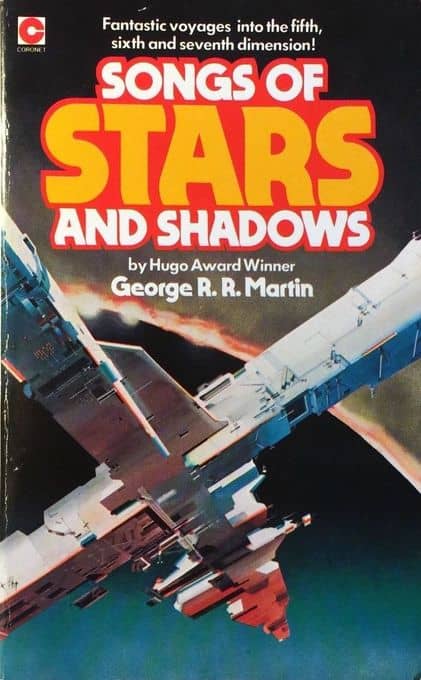 |
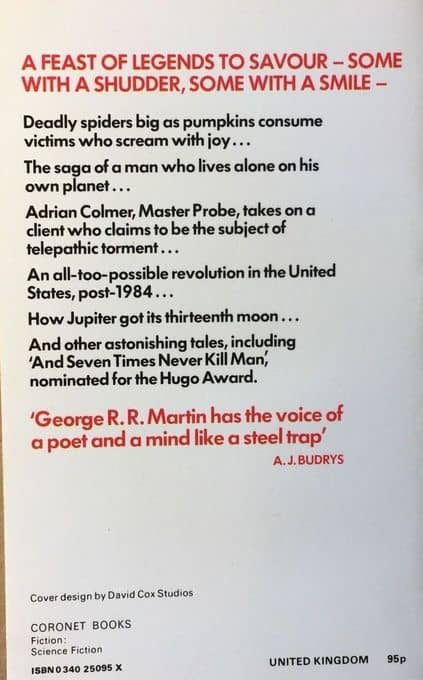 |
Songs of Stars and Shadows (Coronet Books, 1981). Cover by David Cox Studios
Our previous coverage of George R.R. Martin includes:
Vintage Treasures: Tuf Voyaging (2023)
Vintage Treasures: New Voices I: The Campbell Award Nominees edited by George R.R. Martin (2020)
The Golden Age of Science Fiction: “Sandkings,” by Steve H Silver (2019)
The Golden Age of Science Fiction: “The Way of Cross And Dragon,” by Steve H Silver (2019)
Vintage Treasures: Songs of Stars and Shadows (2018)
On Rivers of Blood: Fevre Dream by Joe Bonadonna (2018)
A Tale of Three Covers: Nightflyers (2018)
A Knight of The Seven Kingdoms by George R. R. Martin (2015)
Old Venus, edited by George R.R. Martin and Gardner Dozois (2014)
Rogues, edited by George R.R. Martin and Gardner Dozois (2014)
Top Five Differences between HBO’s Game Of Thrones and George R.R. Martin’s A Game Of Thrones by Elizabeth Eckhart (2014)
Old Mars, edited by George R.R. Martin and Gardner Dozois (2014)
Vintage Treasures: George R.R. Martin’s Nightflyers (2012)
George R. R. Martin Weds Parris McBride (2011)
A Review of Warriors, edited by George R.R. Martin & Gardner Dozois, by Jason Waltz (2010)
Sandkings was published by David G Hartwell’s Timescape imprint at Pocket Books as a paperback original in December 1981. It is 238 pages, priced at $2.75. The cover is by Rowena Morrill.
See all our coverage of the best classic SF and Fantasy here.
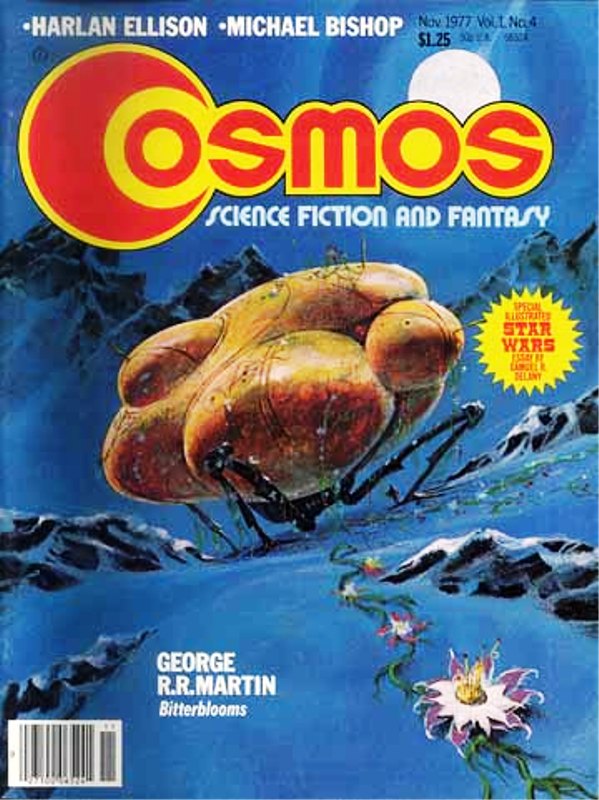
UPDATE
The continued growth of Black Gate has caused some recent issues (you may have noticed a few of UNABLE TO CONNECT TO DATABASE errors over the past two weeks). Today we updated to a dedicated server, using a site backup from late Friday, which should be significantly faster — and give us a lot more room to grow.
Unfortunately that meant that Saturday and Sunday’s post had to be re-published. This article had 10 comments, which I made sure to screen capture before the site migration. I’ll post them below, with apologies to the original commentors for the inconvenience. Thanks for your understanding.
Comment #1 from Eugene R.
Yes, the level of pseudo-science content in Omni was a bit higher than I prefer for a science-y publication. But the Games columns with Mr. Gardner were good, the design/layout was very imaginative, and the art was eye-catching. Through the years/moves, I have kept the October “anniversary” issues, from the first (1978) on.
Comment #2 from Chris.
Comment #3 from Thomas Parker.
Comment #4 from Chuck Timpko.
Comment #5 from Joe H.
Comment #5 from K. Jespersen.
Thanks for the repost. And congratulations on the new server! Hopefully it will serve Black Gate excellently.
Seems to be working okay so far. Fingers crossed!